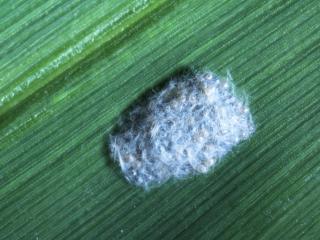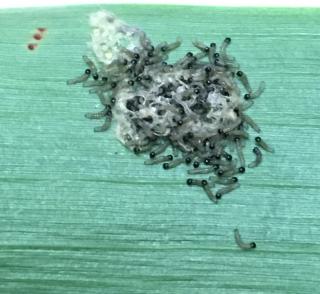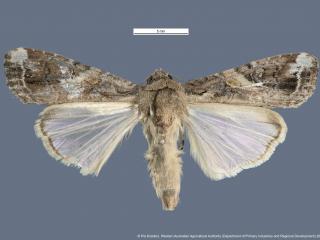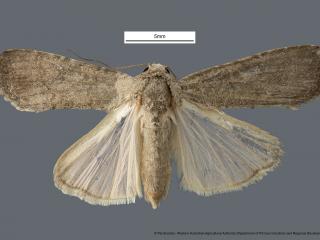Identification
The fall armyworm (Spodoptera frugiperda) is a plant pest that can damage a wide variety of crops. The larvae predominantly feed on crops and pastures from the Poaceae (grass) family, in particular maize, but also sorghum, forage grasses, turf grasses, cereals and rice. The pest can also feed on non-grass crops such as cotton, peanuts, vegetables and some fruit crops. Fall armyworm is known for its ability to disperse and migrate long distances, which enables it to exploit new habitats and expand its range.
The Department of Primary Industries and Regional Development (DPIRD) is conducting surveillance on the spread of fall armyworm across north Western Australia. Early detection and reporting of fall armyworm will help protect the State’s plant industries and the environment.
Fall armyworm have four life stages: eggs, larvae (caterpillar), pupae and adult (moth).
Identifying fall armyworm from the eggs, pupae and adult moths is very difficult. The larvae have key identification features growers can use, however many larvae present in Western Australian crops look similar to fall armyworm.
For a detailed look at the identification characteristics of fall armyworm, watch the webinar conference presentation or read the PowerPoint presentation by DPIRD senior laboratory scientist Melinda Moir, delivered on 9 April 2020 to growers, agronomists and stakeholders.
Eggs
Fall armyworm eggs are pale yellow coloured and laid as an egg mass, which often contains 100–200 eggs. Egg masses are laid on leaves and covered with a layer of hairs and scales shed by the female moth.
Larvae
The appearance of larvae changes as they develop through the life cycle. When larvae first hatch from the eggs, they are light coloured with a larger dark head.
As they develop, the body of fall armyworm larvae become darker with white lengthwise stripes. They also develop dark spots with spines. The colour can vary from light green to a dark brown and black.
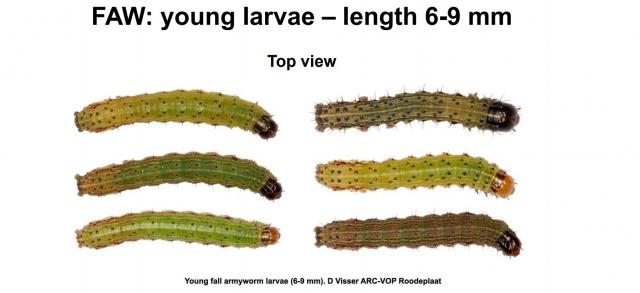
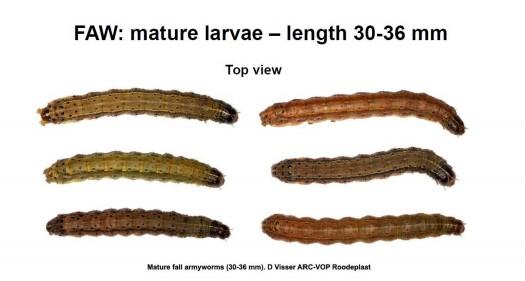
Key features found on larvae can be used for identification. For more details, see the Fall armyworm larval identification guide.
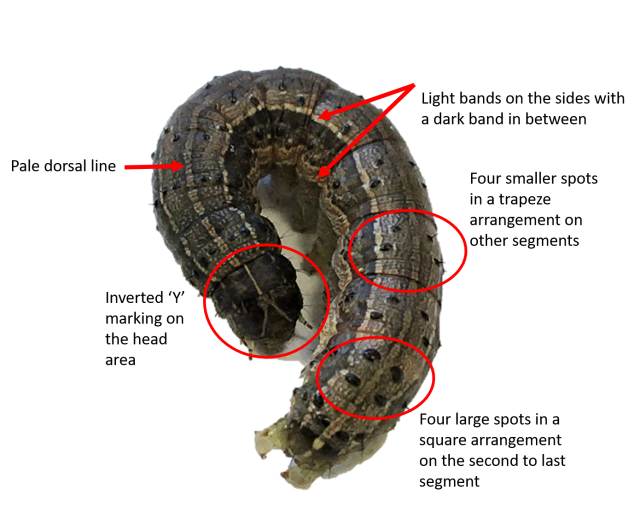
Adults
Identification of fall armyworm moths is very difficult and requires an expert. There are many other species of moths that look similar to fall armyworm.
The adult moths are 32-40mm in length from wing tip to wing tip, with a brown or grey forewing and a white hind wing. Male fall armyworm moths have more patterns on their wings than the females. Males also have a distinct white spot on each of their forewings.
What else could it be?
Table A lists pest moths in the crop that could be confused with fall armyworm (as at 20 May 2020)
| Common name | Species name | Crops in which it is found |
| Cluster caterpillar, tobacco cutworm | Cotton, maize, sorghum, pastures, hay | |
| Beet armyworm | Beets, asparagus, beans, peas, cabbage, pepper, tomato, lettuce, celery, strawberry, eggplant, sugar beet, alfalfa, cole crops, potato, cotton, cereals, oilseeds, tobacco, flowers and weed species | |
| African armyworm | Cereals, maize, rice, sorghum, sugarcane, and pasture grasses, especially Cynodon and Pennisetum species | |
| Native budworm | Maize, cotton, canola, pulses, sunflower, flax, pasture legumes, fruit and vegetable crops | |
| Corn earworm, cotton bollworm | Major hosts: maize, tomato, cotton, pigeon pea, chickpea, rice, sorghum, and cowpea. Other hosts include: groundnut, okra, peas, field beans, soybeans, lucerne, Phaseolus spp., other Leguminosae, tobacco, potatoes and flax | |
| Lesser budworm | Cereals and lucerne | |
| Northern armyworm | Rice, maize, sorghum, wheat, sugarcane and wild grasses | |
| Common armyworm | Poaceae spp. (inc. cereals and grasses), pineapple, sweet potato and lucerne | |
| Sugarcane armyworm | Sugarcane, Poaceae spp. (inc. cereals and grasses) | |
| Southern armyworm | Poaceae spp. (inc. cereals and grasses), peas and flax | |
| Inland armyworm | Poaceae (inc. cereals and grasses) | |
| Black cutworm | Maize, crops and weeds |

